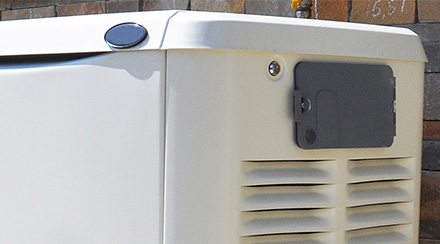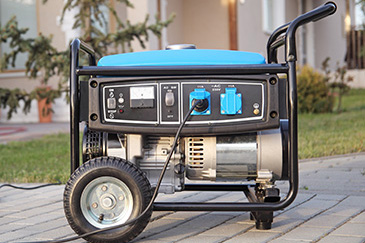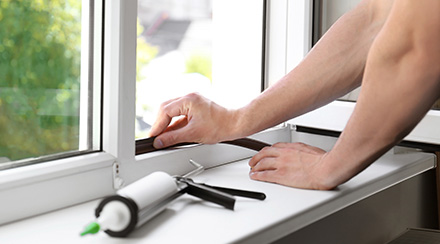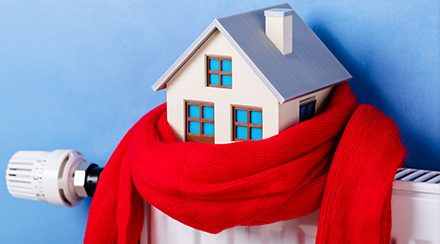How to Choose a Generator for Your Home

If you’ve ever endured a storm or hurricane which has resulted in a power outage, you know what a miserable experience it can be. There’s the discomfort of being without climate control, the boredom of missing your electronics, the waste of a fridge full of spoiled food – and in some cases, power outages can even pose health and safety risks. But if you’re prepared with an emergency generator, you can keep your family safe and comfortable until power is fully restored.
Generators range in price from a few hundred dollars to several thousand, and there are numerous brands and models to choose from. Don’t wait until your power is out to start thinking about this home upgrade; it’s a high-involvement purchase that may require professional installation, so advance planning is key.
The Four Types of Generators
While generators vary in their features and fuel types, most fall into one of four categories: standby generators, portable generators, inverter generators and solar generators.
Standby generators, sometimes called whole home generators, must be professionally installed and are permanent fixtures to a home. The main unit is installed outside, similar to a central air conditioner. These units are typically powered by natural gas or propane and start up automatically when a power interruption is detected. When your home is powered by a standby generator, you can continue to use your electrical outlets and appliances as you normally would.
Portable generators can be stored in a garage or shed until they’re needed, at which point they can be wheeled to a suitable area and set up. Appliances and electronics can be connected directly to portable generators using special extension cords, or the generator can be connected directly to a home’s electrical grid, where it can function as a whole home generator. This requires a modification called a transfer switch, which should be installed by a licensed electrician. Most portable generators run on gasoline, but some may use diesel, propane or natural gas. They produce carbon monoxide, so they must be set up in ventilated areas away from living spaces.
Inverter generators are so-called because of the specific way they generate electricity. These models produce electricity in multiple phases, converting it from alternating current to direct current and then back into alternating current. Some standby generators use this technology, but most inverter generators are portable generators. They can be more appealing than traditional portable generators because they’re quieter and produce a more stable flow of electricity that is better for sensitive electronics. But just like portable generators, they typically run on gasoline or diesel and must therefore be positioned carefully to allow the safe ventilation of carbon monoxide.
Solar generators use solar panels to harvest the free energy of the sun and store it in a battery. They don’t produce as much electricity as models that run on other fuels, so they’re not practical for powering major appliances like refrigerators or HVAC systems, but they can generate enough free energy to provide the simple comforts of small electronics and appliances. These units do not produce carbon monoxide and can usually be operated indoors, with the panels set up outside. Because the sun is needed to charge the battery, solar generators can only generate electricity during the day and will charge slower during cloudy weather.
Key Considerations When Choosing a Generator

Before you start shopping, there are a few factors that are important to consider:
- Generator cost. The whole house generator cost for the generator itself can be between $2,000 and $8,000, or even more for the most powerful models, but that doesn’t include the cost of installation. Expect installation to cost between 70 and 100 percent of the cost of the generator. If this is out of your price range, you’re best off shopping for a portable generator, where models range from around $300 for the least powerful units to a few thousand dollars for the most powerful units.
- Essential appliances. Maybe a whole home generator isn't the best fit, but you still want some emergency backup power. Make a list of the appliances you consider most important, like your refrigerator, coffee maker and a few lights. If powering your entire HVAC system requires a generator outside of your budget, you might consider a smaller window air conditioner and a few electric fans to be essential.
- Frequency of power outages. If your area experiences outages frequently, you might want to plan financing for a larger standby generator. But if they’re less common, a more affordable portable generator may make more sense.
- Location of operation. Any fuel-burning portable generator must be set up at least 20 feet away from your home, far away from any vents or open windows. It should also be protected from inclement weather with something like a portable canopy tent that is open on all sides. Spare fuel must be stored in a safe place, preferably outside of your living space. If you’re in a multi-unit building or on a small lot, you might not have an adequate space to operate a fuel-burning generator safely.
- Other costs. If you’re buying a standby generator, your professional installer should be able to give you a detailed rundown of all the costs. But if you’re buying a portable generator, there are other expenses to consider. The biggest cost is a transfer switch, which you’ll want to install if you plan on using a portable generator to power your whole home. An electrician may charge between $500 and $1,500 for this modification. If you’d rather connect individual appliances directly to your generator, you’ll need to buy special extension cords rated for generator use. These must be long enough to reach your appliances without placing the generator too close to your home. Smaller costs may include a rain canopy, fuel stabilizers and the fuel itself.
| Standby | Portable | Inverter | Solar | |
| Pros | Automatic start; powers whole home with no setup | Low upfront cost; multiple fuel options | Quiet operation; better for sensitive electronics | Free fuel supply; low upfront cost |
| Cons | High equipment and installation costs | Access to fuel supply required; strict safety guidelines | Access to fuel supply required; strict safety guidelines | Dependent on available sunshine |
| Total Cost | $3,000 to $16,000 or possibly more, depending on size | $300 to $2,500, depending on size | Comparable to standby and portable, depending on type and size | $100 to $5,000, depending on size |
| Capacity | Most are between 7kW and 50kW, but can go much higher | Most are between 1kW and 7.5kW | Can be either standby or portable, with comparable ranges | Most are between 400W and 5kW |
| Installation | Requires professional installation | Transfer switch installation required for electrical panel hookup; no installation when using extension cords | Comparable to standby and portable, depending on type | Transfer switch installation required for electrical panel hookup; no installation when using extension cords |
| Location | Permanent unit outside the home | Must be positioned at least 20 feet away from home | Comparable to standby and portable, depending on type | Anywhere with available sunshine and within reach of extension cords |
| Connection Type | Permanent connection to electrical panel | Can be connected to electrical panel with transfer switch or used with generator-grade extension cords | Comparable to standby and portable, depending on type | Can be connected to electrical panel with transfer switch or used with generator-grade extension cords |
| Fuel Type | Natural gas, propane or diesel | Gasoline, propane, diesel or natural gas | Gasoline, propane, diesel or natural gas | Sunlight |
How Many Watts Do I Need My Generator to Produce?
Determining your wattage needs may require a little bit of research. Every appliance or device has a surge wattage and a running wattage. When an appliance starts up, it will initially draw its higher surge wattage before settling at its running wattage. You can look for these wattages in your owner's manuals, on appliance manufacturer websites or on labels on the appliances themselves.
The sum of the surge wattages of all your essential appliances should give you a good idea of the maximum wattage you’ll need your generator to produce. If this results in a generator that is out of your budget, you may be able to use a smaller generator by starting up your appliances one at a time. The key is to make sure you never exceed the generator’s wattage limit through surging appliances.
An easier way to calculate your wattage needs is to hire an electrician to conduct a load measurement. This is a professional assessment of your home’s electrical needs, and it’s especially important to have this done if you’re thinking about investing in a whole home standby generator.
Looking for Something Specific?
Select a category to find resources for topics that interest you.
Select Category

Related Articles:

What to Do Before, During and After Power Outages
With a little knowledge and preparation, you can protect yourself, your home and your belongings during power outages of any duration.
Read Article
Weatherize Your Home for Summer
The extreme heat of summer can really do a number on your energy bills. But if you’re able to invest a little time and money into weatherizing to keep your home cool, you can help yourself and your family remain comfortable at home while still saving energy.
Read Article
How to Weatherize Your Home for Winter
No matter how much you may enjoy walking in a winter wonderland, the frosty elements can take a toll on your home, yard and utility bills. So before the temperature plummets, it’s important to take some time to weatherize your home for winter.
Read ArticleHow to Choose a Generator for Your Home
If you’ve ever endured a storm or hurricane which has resulted in a power outage, you know what a miserable experience it can be. There’s the discomfort of being without climate control, the boredom of missing your electronics, the waste of a fridge full of spoiled food – and in some cases, power outages can even pose health and safety risks. But if you’re prepared with an emergency generator, you can keep your family safe and comfortable until power is fully restored.
Generators range in price from a few hundred dollars to several thousand, and there are numerous brands and models to choose from. Don’t wait until your power is out to start thinking about this home upgrade; it’s a high-involvement purchase that may require professional installation, so advance planning is key.
The Four Types of Generators
While generators vary in their features and fuel types, most fall into one of four categories: standby generators, portable generators, inverter generators and solar generators.
Standby generators, sometimes called whole home generators, must be professionally installed and are permanent fixtures to a home. The main unit is installed outside, similar to a central air conditioner. These units are typically powered by natural gas or propane and start up automatically when a power interruption is detected. When your home is powered by a standby generator, you can continue to use your electrical outlets and appliances as you normally would.
Portable generators can be stored in a garage or shed until they’re needed, at which point they can be wheeled to a suitable area and set up. Appliances and electronics can be connected directly to portable generators using special extension cords, or the generator can be connected directly to a home’s electrical grid, where it can function as a whole home generator. This requires a modification called a transfer switch, which should be installed by a licensed electrician. Most portable generators run on gasoline, but some may use diesel, propane or natural gas. They produce carbon monoxide, so they must be set up in ventilated areas away from living spaces.
Inverter generators are so-called because of the specific way they generate electricity. These models produce electricity in multiple phases, converting it from alternating current to direct current and then back into alternating current. Some standby generators use this technology, but most inverter generators are portable generators. They can be more appealing than traditional portable generators because they’re quieter and produce a more stable flow of electricity that is better for sensitive electronics. But just like portable generators, they typically run on gasoline or diesel and must therefore be positioned carefully to allow the safe ventilation of carbon monoxide.
Solar generators use solar panels to harvest the free energy of the sun and store it in a battery. They don’t produce as much electricity as models that run on other fuels, so they’re not practical for powering major appliances like refrigerators or HVAC systems, but they can generate enough free energy to provide the simple comforts of small electronics and appliances. These units do not produce carbon monoxide and can usually be operated indoors, with the panels set up outside. Because the sun is needed to charge the battery, solar generators can only generate electricity during the day and will charge slower during cloudy weather.
Key Considerations When Choosing a Generator
Before you start shopping, there are a few factors that are important to consider:
- Generator cost. The whole house generator cost for the generator itself can be between $2,000 and $8,000, or even more for the most powerful models, but that doesn’t include the cost of installation. Expect installation to cost between 70 and 100 percent of the cost of the generator. If this is out of your price range, you’re best off shopping for a portable generator, where models range from around $300 for the least powerful units to a few thousand dollars for the most powerful units.
- Essential appliances. Maybe a whole home generator isn't the best fit, but you still want some emergency backup power. Make a list of the appliances you consider most important, like your refrigerator, coffee maker and a few lights. If powering your entire HVAC system requires a generator outside of your budget, you might consider a smaller window air conditioner and a few electric fans to be essential.
- Frequency of power outages. If your area experiences outages frequently, you might want to plan financing for a larger standby generator. But if they’re less common, a more affordable portable generator may make more sense.
- Location of operation. Any fuel-burning portable generator must be set up at least 20 feet away from your home, far away from any vents or open windows. It should also be protected from inclement weather with something like a portable canopy tent that is open on all sides. Spare fuel must be stored in a safe place, preferably outside of your living space. If you’re in a multi-unit building or on a small lot, you might not have an adequate space to operate a fuel-burning generator safely.
- Other costs. If you’re buying a standby generator, your professional installer should be able to give you a detailed rundown of all the costs. But if you’re buying a portable generator, there are other expenses to consider. The biggest cost is a transfer switch, which you’ll want to install if you plan on using a portable generator to power your whole home. An electrician may charge between $500 and $1,500 for this modification. If you’d rather connect individual appliances directly to your generator, you’ll need to buy special extension cords rated for generator use. These must be long enough to reach your appliances without placing the generator too close to your home. Smaller costs may include a rain canopy, fuel stabilizers and the fuel itself.
| Standby | Portable | Inverter | Solar | |
| Pros | Automatic start; powers whole home with no setup | Low upfront cost; multiple fuel options | Quiet operation; better for sensitive electronics | Free fuel supply; low upfront cost |
| Cons | High equipment and installation costs | Access to fuel supply required; strict safety guidelines | Access to fuel supply required; strict safety guidelines | Dependent on available sunshine |
| Total Cost | $3,000 to $16,000 or possibly more, depending on size | $300 to $2,500, depending on size | Comparable to standby and portable, depending on type and size | $100 to $5,000, depending on size |
| Capacity | Most are between 7kW and 50kW, but can go much higher | Most are between 1kW and 7.5kW | Can be either standby or portable, with comparable ranges | Most are between 400W and 5kW |
| Installation | Requires professional installation | Transfer switch installation required for electrical panel hookup; no installation when using extension cords | Comparable to standby and portable, depending on type | Transfer switch installation required for electrical panel hookup; no installation when using extension cords |
| Location | Permanent unit outside the home | Must be positioned at least 20 feet away from home | Comparable to standby and portable, depending on type | Anywhere with available sunshine and within reach of extension cords |
| Connection Type | Permanent connection to electrical panel | Can be connected to electrical panel with transfer switch or used with generator-grade extension cords | Comparable to standby and portable, depending on type | Can be connected to electrical panel with transfer switch or used with generator-grade extension cords |
| Fuel Type | Natural gas, propane or diesel | Gasoline, propane, diesel or natural gas | Gasoline, propane, diesel or natural gas | Sunlight |
How Many Watts Do I Need My Generator to Produce?
Determining your wattage needs may require a little bit of research. Every appliance or device has a surge wattage and a running wattage. When an appliance starts up, it will initially draw its higher surge wattage before settling at its running wattage. You can look for these wattages in your owner's manuals, on appliance manufacturer websites or on labels on the appliances themselves.
The sum of the surge wattages of all your essential appliances should give you a good idea of the maximum wattage you’ll need your generator to produce. If this results in a generator that is out of your budget, you may be able to use a smaller generator by starting up your appliances one at a time. The key is to make sure you never exceed the generator’s wattage limit through surging appliances.
An easier way to calculate your wattage needs is to hire an electrician to conduct a load measurement. This is a professional assessment of your home’s electrical needs, and it’s especially important to have this done if you’re thinking about investing in a whole home standby generator.
Looking for Something Specific?
Select a category to find resources for topics that interest you.
Select Category

Related Articles:

What to Do Before, During and After Power Outages
With a little knowledge and preparation, you can protect yourself, your home and your belongings during power outages of any duration.
Read Article
Weatherize Your Home for Summer
The extreme heat of summer can really do a number on your energy bills. But if you’re able to invest a little time and money into weatherizing to keep your home cool, you can help yourself and your family remain comfortable at home while still saving energy.
Read Article
How to Weatherize Your Home for Winter
No matter how much you may enjoy walking in a winter wonderland, the frosty elements can take a toll on your home, yard and utility bills. So before the temperature plummets, it’s important to take some time to weatherize your home for winter.
Read Article






